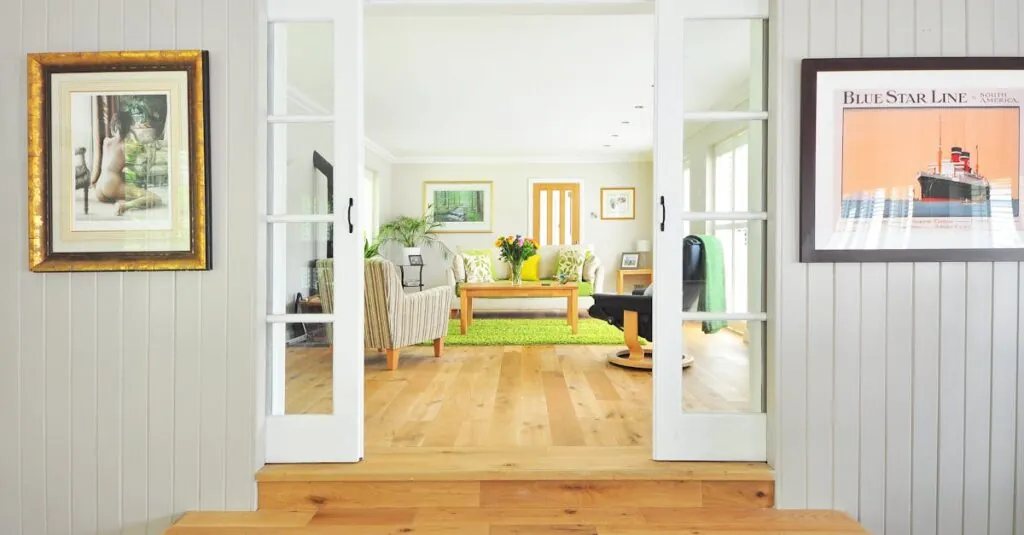Imagine stepping into a living room that feels like a breath of fresh air—crisp, clean, and undeniably chic. A minimalist white living room isn’t just a design choice; it’s a lifestyle statement. With its bright, airy vibes, this aesthetic transforms any space into a serene sanctuary, perfect for unwinding after a long day or hosting friends for a book club that may or may not be a front for wine tasting.
But don’t let the simplicity fool you. Creating a minimalist white living room is an art form that balances elegance and functionality. It’s about embracing the beauty of less and turning your space into a canvas where every piece tells a story. So grab your favorite throw pillow and let’s dive into the world of minimalist design that’ll have you saying goodbye to clutter and hello to style.
Table of Contents
ToggleOverview of Minimalist White Living Rooms
Minimalist white living rooms embody simplicity combined with elegance. These spaces thrive on a limited color palette dominated by white, creating a sense of openness and tranquility. Natural light plays a crucial role, highlighting the room’s features and enhancing its airy atmosphere.
Furniture selection focuses on functional yet aesthetically pleasing pieces. Clean lines and geometric shapes dominate furniture designs, contributing to the overall uncluttered look. Cozy textures such as wool or cotton also add warmth, ensuring the room remains inviting despite its minimalist ethos.
Decor items maintain a strategic approach, with each piece carefully chosen for both style and purpose. Artwork, plants, or decorative accents typically find their place within the minimalist framework, seamlessly integrating into the design without overwhelming the space.
Furniture arrangement emphasizes flow and accessibility. Open layouts promote movement, allowing easy navigation while showcasing the room’s design elements. In addition, neutral accessories serve as subtle enhancements, complementing the white backdrop while offering visual interest.
Embracing this style encourages a lifestyle that prioritizes mindfulness and intentional living. By reducing distractions, inhabitants can enjoy serene environments conducive to relaxation and social interaction. Minimalist white living rooms not only provide an appealing aesthetic but also foster a sense of well-being through simplicity and order.
Key Features of Minimalist White Living Rooms
Minimalist white living rooms showcase a refined aesthetic defined by simplicity and a well-considered design approach. Key elements such as color palette and furniture selection play vital roles in establishing this tranquil environment.
Color Palette
A minimalist white living room emphasizes a limited color palette. White dominates, creating a sense of openness and clarity. Accents of soft grays or muted pastels enhance the serene atmosphere without overwhelming the space. Strategic use of these subtle colors can complement the minimalist approach, promoting visual harmony. Additionally, natural elements such as wood tones or potted plants provide warmth and texture, ensuring the space remains inviting.
Furniture Selection
Functional furniture defines a minimalist white living room. Clean lines and geometric shapes enhance the overall aesthetic while maintaining visual clarity. Pieces made from materials like metal or light wood blend seamlessly into the design. Each item should serve a purpose, contributing to an uncluttered environment. Textiles such as soft cotton or airy linen add comfort without compromising simplicity. Prioritizing quality over quantity in furniture selection fosters a cohesive look that supports relaxation and social interaction.
Benefits of a Minimalist White Living Room
A minimalist white living room offers various advantages that contribute to a serene and stylish home environment. This aesthetic not only enhances the overall look but also promotes well-being through thoughtful design choices.
Aesthetic Appeal
A minimalist white living room exudes sophistication. The use of a limited color palette creates a smooth and harmonious atmosphere. Subtle accents in soft grays or muted pastels enhance the beauty without overwhelming the senses. Clean lines and geometric shapes in furniture play a significant role in achieving an elegant view. Each chosen decor item serves a purpose, ensuring that the space remains uncluttered. By prioritizing functionality and beauty, this aesthetic successfully merges style with practicality.
Enhanced Sense of Space
An airy, minimalist white living room fosters an open and inviting atmosphere. Natural light plays a crucial role in illuminating the room, making it feel larger and more welcoming. Furniture arrangement focuses on flow and accessibility, promoting easy movement throughout the space. This design encourages an uncluttered environment that enhances relaxation. The inclusion of natural elements, such as wood tones or potted plants, adds warmth and texture, refreshing the space further. With intentional design, a minimalist white living room creates a tranquil refuge, remarkably elevating everyday living experiences.
Tips for Designing a Minimalist White Living Room
Creating a minimalist white living room requires intentional choices in furniture and decor. These decisions play a significant role in achieving a serene and sophisticated atmosphere.
Choosing the Right Furniture
Select furniture that emphasizes clean lines and practicality. Look for pieces crafted from materials like wood or metal to maintain an uncluttered look. Each item should serve a distinct purpose, contributing to the overall simplicity of the space. Consider sofas and chairs with low profiles that promote openness. A coffee table with a clear glass top can enhance the airy feel. Prioritize multi-functional furniture, such as ottomans that double as storage. This approach not only maintains order but also fosters a sense of calm within the room.
Incorporating Texture and Accessories
Incorporate various textures to create visual interest in the minimalist design. Soft textiles like cotton and linen can add warmth without overwhelming the aesthetic. Use decorative items sparingly, choosing a few well-placed pieces that resonate with the style. Potted plants bring a natural element and infuse life into the space. Keep accessories neutral to harmonize with the white palette, ensuring they complement rather than compete for attention. Consider incorporating rugs with subtle patterns to anchor the arrangement while maintaining simplicity. Each texture and accessory reinforces the minimalist theme, enhancing the overall appeal while promoting tranquility.
A minimalist white living room stands as a testament to the beauty of simplicity. By prioritizing clean lines and intentional design choices, it creates a serene environment that encourages relaxation and mindfulness. The thoughtful arrangement of furniture and decor enhances both functionality and aesthetic appeal.
Incorporating natural elements and textures adds warmth while maintaining the overall tranquility of the space. This design approach not only elevates the visual experience but also fosters a lifestyle centered around clarity and order. Embracing a minimalist white living room can transform daily living into a more peaceful and enjoyable experience.









